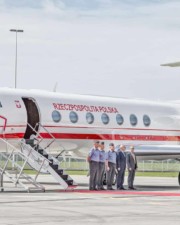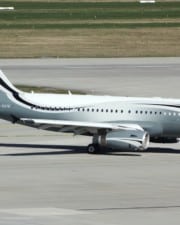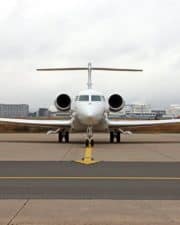Airplanes are built for missions, even if they fly in the civilian world. Nowhere is mission-based design more evident than in the world of private jets, where there is a jet for every customer. Some are super fast, some are ultra-long range, and some are as luxurious as a palace.
Private jets fall into eight different categories, ranging from tiny very light jets to corporate airliners based on super jumbo jets like the Boeing 747 or A380. These categories are roughly grouped by the size of the plane, but as the planes get bigger they tend to also carry more passengers, more baggage, and more fuel so that they can fly longer routes.
While private jets are certainly status symbols for the super-wealthy such as golfers, they are also used in the business world to increase productivity and reduce wasted travel time, as well as by some pastors. The interiors of these planes are quiet and distraction-free, the perfect environment to keep working while en route.
A vast majority of these types of jets are owned by charter companies. There are many business models, but charters are available from operators big and small around the world. In the US, these operators are certified by the FAA under FAR Part 135–Non-Schedule Air Carriers.
If a corporation does a lot of flying, it makes financial sense for them to set up their own flight department. Corporate aviation allows executives to get to their destinations faster and to arrive refreshed and relaxed. They can use secondary airports that are likely closer to their destination, and their schedules aren’t thrown asunder by airline delays and cancelations.
In the United States, many of these jet models are operated by the Air Force for special-purpose missions. The most famous example is Air Force One, the executive-configured 747 used by the President. But there are other examples, including a 757 used by the Vice President and many smaller corporate jets used for moving dignitaries and high-ranking officers between bases. NOAA and NASA operate Gulfstreams, among other jets, for atmospheric research.
1. Very Light Jets (VLJs)
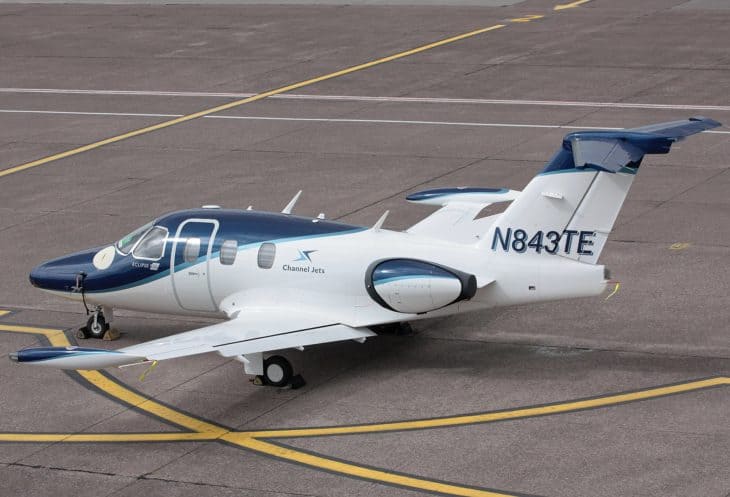
If a single or twin-engine piston airplane doesn’t have quite the oomph you desire, you might be in the market for a VLJ. The smallest types of private jet, VLJs have only been on the market since the late 1990s when the revolutionary Eclipse Jet hit the scene.
Their small cabins only seat four or five people, so they are best suited for owners who want to fly themselves and their families on trips. But there are also several air taxi operators who use them to ferry passengers from one point to another quickly.
The cabins are like other light aircraft with big comfortable seats, but not enough room to get up and move around. Consider them like traveling inside a really, really fast SUV. Since they are aimed at owner/operators, their cockpits are sleek and they are designed with a focus on ease of flying. Most are equipped with FADEC engine technology and glass cockpits.

With a few exceptions, VLJ manufacturers are piston aircraft companies looking to expand their product lines. Companies like Cirrus, Piper, and Diamond have all put forward designs in the VLJ market as their first foray into jets. Others, like Eclipse and Honda, are new to aviation and focusing solely on the VLJ market. Embraer and Cessna are well-established jet manufacturers who have produced smaller VLJs to compete.
Just as the VLJ market began to take off, the Great Recession of 2007 put many manufacturer’s plans on hold. After more than a decade, new models are popping up again.
Examples of VLJs include the Eclipse 500/550, HondaJet, Embraer Phenom 100, Cessna Citation Mustang, and the Cirrus Jet.
2. Small Light Jets

Before there were VLJ, there were small light jets. These are the smaller siblings of their bigger brothers and sisters, mostly made by the main business jet manufacturers like Hawker, Learjet, Dassault Falcon, and Cessna Citation.
Unlike VLJs, these planes have room to move between seats and a small lavatory area. The cabins are small, so don’t expect stand up headroom. They usually carry six to eight people comfortably in single row seating, with lots of room to recline the seat.
Small light jets like the Hawker 400XP, the Cessna Citation CJ2, and the Dassault Falcon 10 are common sights at secondary airports around the world.
3. Super Light Jets
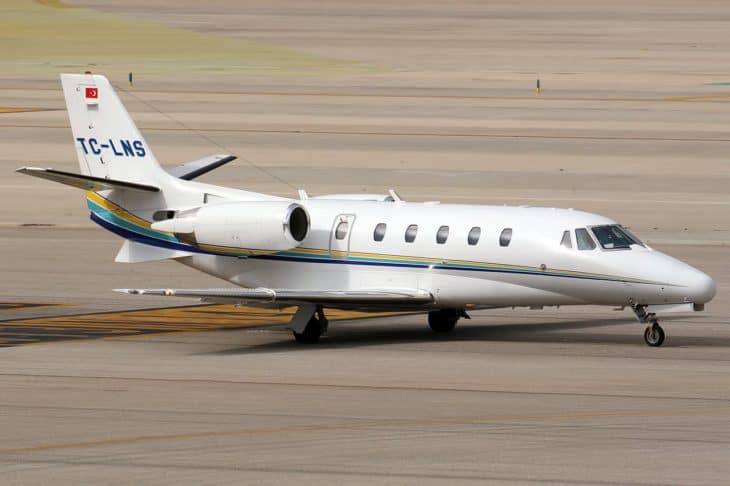
A slightly stretched version is the super-light jet, these jets can carry between eight and eleven passengers, depending on the model. They have more room for luggage and a better range than smaller jets.
These jets are the best bet for longer hops, with ranges near 2,000 nm in some models. They’re also still small enough to be able to operate out of smaller airports, which is handy if the fliers are looking to visit smaller towns. They usually have enough space for enclosed lavatories and miniature galleys, as well.
Even though the cabins aren’t large, they have big comfortable seats that recline. The cabins are usually well-appointed, similar to first-class airline service but without all of the other passengers.
Examples of super light jets include the Gulfstream G100, Embraer Phenom 300, and the Cessna Citation XLS.
4. Midsize Cabin Jets
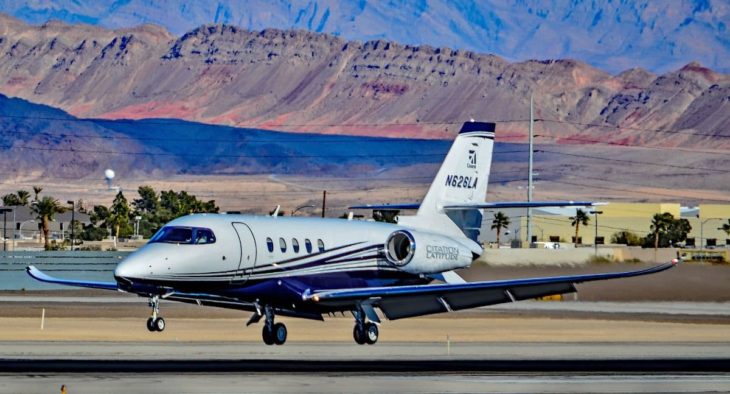
Midsize cabin jets are the smallest planes that offer stand-up headroom. They’re also big enough to be able to travel well over 2,000 nm each flight, meaning that they can operate transcontinental flights in North America.
Another distinction of midsize cabins is that they are usually served by a flight attendant. Just like airline flight attendants, private aviation FAs provide refreshments and meal service, as well as performing safety functions in the event of an emergency.
This size jet will have lavatories and galleys for onboard entertainment and meal service. Even with all of these amenities, they can still operate at smaller airports and from relatively short runways.
Examples of midsize cabin jets are the Gulfstream G150, Cessna Citation Latitude, and the Learjet 60.
5. Super Midsize Cabin Jets

Need to stay aloft even longer? Most super-midsize jets have an endurance of over seven hours, making their range in excess of 3,500 nm. On average they carry between ten and twelve passengers in much more luxurious accommodations than their smaller brethren.
Super midsize jets fit a small market niche between midsize and heavy private jets. Most them happen when manufacturers extend a very successful midsize or shrink a popular heavy jet. However they come about, they serve their mission well–they are smaller and less opulent than their bigger sisters, meaning they less expensive to operate while being able to cross oceans and continents.
Examples super-midsize cabin jets include the Gulfstream G200, Cessna Citation Sovereign, and the Bombardier Challenger 350.
6. Heavy Jets

With an average range of 4,000 nm and first-class accommodations, heavy jets are designed for the highest level of comfort on long haul flights. They can carry between ten and twenty passengers, and their interiors vary dramatically depending on how they’re outfitted.
Some of these jets are designed as corporate people movers, with more seating and more space for long flights. Other are designed to carry fewer people but with luxuries like dining tables and sleeper sofas.
All heavy jets have fully enclosed lavs, sometimes with enclosed showers as well. Full-sized galleys are also standard for providing refreshments and food en route.
Heavy jets commonly seen are the Gulfstream G350, Bombardier Challenger 605, and Dassault Falcon 900.
7. Ultra-Long Range Heavy Jets
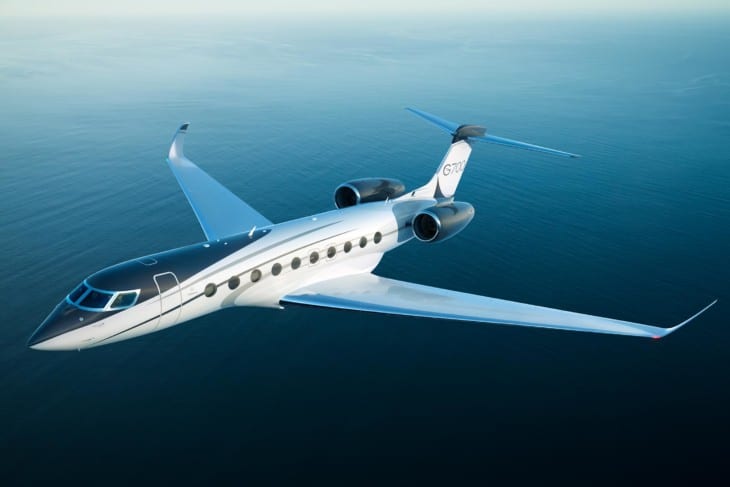
For celebrity A-listers, there’s no better transportation than one’s own G-V (“G-Five”). Gulfstream Aerospace retired those names when they introduced the G500, G550, G600, G650 (and G700 new for 2020). But while the new names are not as catchy, the cliché still stands. These jets are the ultimate status symbol.
Ultra-long range jets are large enough for a big group to cross oceans. They’re used by multinational corporations and are capable of making non-stop ocean crossings. The new G700, for example, has a range of 7,500 nm. That’s more than most heavy airliners, and enough to fly non-stop from New York to Beijing with fuel to spare.
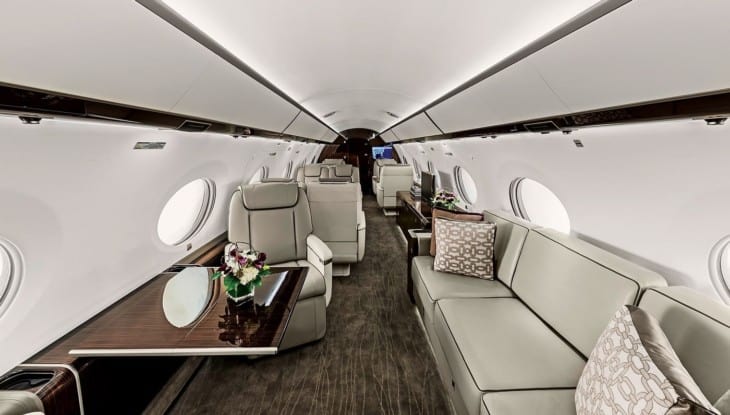
Most ultra-long range jets are decked out with ultra-comfortable interiors too. Many feature staterooms for passengers to rest on long flights. Traveling executives appreciate being able to arrive refreshed and rested when they get to where they’re going. Many feature crew rest areas too, since their are operated on such long flights.
The Gulfstream G500, G600, G550, G650, and G700 are the most famous examples of ultra-long range heavy jets, but there are others like the Dassault Falcon 7X, and Bombardier Global 6000.
8. Executive Airliners

When a G700 just won’t do, the ultimate status symbol is the airliner that has been converted for private or executive use. Bizliners, as they are sometimes called, are either purpose-built by the factory or converted after they’ve been retired from airline use.
Donald Trump owns an easily recognizable 757, John Travolta famously flew his own 707, and the Sultan of Brunei flies in a custom 747. If you’ve got the money, you can even order the world’s largest airliner, the Airbus A380, in an executive configuration!

Boeing, Airbus, and Embraer have extensive marketing programs for their executive airliners. The BBJ was Boeing’s first offering, a customized 737. Nowadays you can order your Boeing corporate jet in any flavor, from the narrow-body 737 to a 747-8 or 777.
The interiors of these bizliners vary considerably since they are all custom ordered. Some will have multiple staterooms allowing the principals and their entourages to relax while traveling. Others will be opulent “palaces in the sky,” like the ACJ380 ordered by the Saudi crown prince.
The BBJ (Boeing Business Jet) was the first example of executive airliner, but now all models of the Boeing, Airbus, and Embraer lines can be customized.
Related Posts



